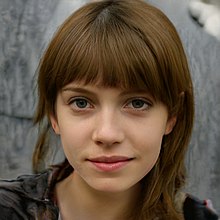
The Style Generative Adversarial Network, or StyleGAN for short, is an extension to the GAN architecture introduced by Nvidia researchers in December 2018,[1] and made source available in February 2019.[2][3]
StyleGAN depends on Nvidia's CUDA software, GPUs, and Google's TensorFlow,[4] or Meta AI's PyTorch, which supersedes TensorFlow as the official implementation library in later StyleGAN versions.[5] The second version of StyleGAN, called StyleGAN2, was published on February 5, 2020. It removes some of the characteristic artifacts and improves the image quality.[6][7] Nvidia introduced StyleGAN3, described as an "alias-free" version, on June 23, 2021, and made source available on October 12, 2021.[8]
- ^ "GAN 2.0: NVIDIA's Hyperrealistic Face Generator". SyncedReview.com. December 14, 2018. Retrieved October 3, 2019.
- ^ "NVIDIA Open-Sources Hyper-Realistic Face Generator StyleGAN". Medium.com. February 9, 2019. Retrieved October 3, 2019.
- ^ Beschizza, Rob (February 15, 2019). "This Person Does Not Exist". Boing-Boing. Retrieved February 16, 2019.
- ^ Larabel, Michael (February 10, 2019). "NVIDIA Opens Up The Code To StyleGAN - Create Your Own AI Family Portraits". Phoronix.com. Retrieved October 3, 2019.
- ^ "Looking for the PyTorch version? - Stylegan2". github.com. October 28, 2021. Retrieved August 5, 2022.
- ^ "Synthesizing High-Resolution Images with StyleGAN2 – NVIDIA Developer News Center". news.developer.nvidia.com. June 17, 2020. Retrieved August 11, 2020.
- ^ NVlabs/stylegan2, NVIDIA Research Projects, August 11, 2020, retrieved August 11, 2020
- ^ Kakkar, Shobha (October 13, 2021). "NVIDIA AI Releases StyleGAN3: Alias-Free Generative Adversarial Networks". MarkTechPost. Retrieved October 14, 2021.